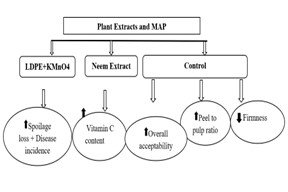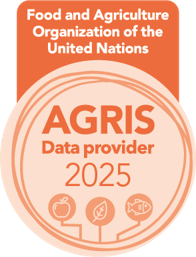Improvement of postharvest quality and shelf life of banana cv. Malbhog using different plant extracts and modified atmosphere packages in Chitwan, Nepal
Abstract
Banana has a very short storage life. It is highly perishable, and therefore susceptible to several diseases resulting in extensive postharvest losses. A research entitled “Improvement of Postharvest Quality and Shelf life of Banana cv. Malbhog using different Plant Extracts and Modified Atmosphere Packages in Chitwan, Nepal” was conducted at the Post-Harvest Horticulture laboratory of Agriculture and Forestry University, Rampur, Chitwan, Nepal. The main objective of the research is to know the appropriate plant extracts and modified atmosphere package (MAP) for banana ripening and to now the effect of different plant extract on disease incidence and severity of banana. The experiment was laid out in Completely Randomized Design which consisted of eight treatments viz. Control, Garlic extracts, Neem extracts, Onion extracts, Sesamum oil, Ginger extract, Unperforated low-density polyethylene (50 µm) containing cotton soaked with KMnO4 and perforated low-density polyethylene (50 µm) containing cotton soaked with KMnO4 respectively and replicated thrice. Different post-harvest parameters were recorded at three days intervals for 15 days. From the experiment, the lowest firmness (0.467kg/cm2) and the highest pulp (4.075) to peel ratio was noted with control. The maximum vitamin C content (6.633 mg/100 g) was recorded with the Neem extract. Regarding the organoleptic test, the index value of overall acceptability (0.87), sweetness (0.80) and flavor (1.0) were depicted highest with control whereas the low-density polyethylene containing cotton dipped in KMnO4 resulted in minimum spoilage loss (43.77%). The minimal disease incidence was noticed with the unperforated LDPE containing KMnO4 (25%) followed by Neem extracts. From the experiment, it was concluded that the low-density polyethylene-containing cotton dipped in KMnO4 and Neem extract performed significantly better in terms of post-harvest parameters and disease incidence. Further studies regarding the use of other plant extracts and modified atmospheric packages were recommended.
Keywords:
Banana, Modified atmosphere package, Plant Extracts, Postharvest life, QualityDownloads
References
Acedo, A. L., & Bautista, O.K. (1991). Enhancing ripening of 'Saba' banana (Musa, BBB group) fruits with Gliricidia leaves as ethylene source. Philippine Agriculturalist, 71, 351-365.
Basel, R. M., Racicot, K., & Senecal, A. G. (2002). Long shelf life banana storage using MAP storage coupled with postharvest MCP treatment. In Annual Meeting and Food Expo-Anaheim, California, USA.
Bhardwaj, R. L., Sen, N. L., & Mukherjee, S. (2005). Effect of benzyladenine on Physico-chemical characteristics and shelf-life of mandarin cv Nagpur Santra. Indian Journal of Horticulture, 62(2), 181-183.
Brinston, K., Dey, P. M., John, M. A., & Pridham, J. B. (1988). Post-harvest changes in Mangifera indica mesocarp cell walls and cytoplasmic polysaccharides. Phytochemistry, 27(3), 719-723
Dadzie, B.K., & Orchard, J.E. (1997). Routin postharvest screening of banana/plantain hybrids criteria and methods. International network for banana and plantain (Inibap), Technical Guidelines. Rome, Italy. pp 75-76.
Gomez, K. A., & Gomez, A. A. (1984). Second Edition / I (second, Vol. 6).
Gonzalez, A., G. A., Buta, J. G., & Wang, C. Y. (2003). Methyl jasmonate and modified atmosphere packaging (MAP) reduce decay and maintain postharvest quality of papaya ‘Sunrise’. Postharvest Biology and Technology, 28(3), 361-370.
Habiba, U. (2012). Effects Of Different Plant Extracts On Shelf Life And Quality Of Banana (Doctoral Dissertation).
Hailu, M., Workneh, T. S., & Belew, D. (2013). Review on postharvest technology of banana fruit. African Journal of Biotechnology, 12(7): 635-647
Islam, M.,& Rul, K. (2014). Effects of Different Levels of Ethylene Scavenging Compound on Shelf Life and Quality of Banana (Doctoral Dissertation, Myensingh University, Bangladesh).
Khatiwada, B. P. (2005). Ripening regulation of banana (Musa sapientum L.) cv. Malbhog using chemicals and indigenous plant materials. Msc thesis. Department of horticulture. Institute of Agriculture and Animal Science. Rampur, Chitwan, Nepal. 88 pp.
Kishore, K., Bharali, R., Pathak, K. A., & Yadav, D. S. (2006). Studies on ripening changes in purple passion fruit (Passiflora edulis Sims). Journal of Food Science and Technology-Mysore, 43(6), 599-602.
Khatun, M.M. (2012). Effects of different postharvest treatments on storage behavior and Physico-chemical properties of Banana (Doctoral Dissertation).
Mahajan, B. V. C., Singh, G., & Dhat, A. S., (2008). Studies on ripening behavior and quality of winter guava with ethylene gas and ethephon treatment. J. Food Sci. Technol., 45(1): 81-84
Mari, M., Bertolini, P.,& Pratella, G. C. (2003). Non‐conventional methods for the control of post harvest pear diseases. Journal of Applied Microbiology, 94(5), 761-766.
Mimi, M. A. (2013). Study of shelf life and quality of different banana varieties (doctoral dissertation).
Mondal, M. F. (2000). Production and storage of fruits (in Bangladesh). Published by Mrs. Afia Mondal, BAU Campus, Mymensingh-2202, 312.
Pathak, N., & Sanwal, G. G. (1991). Regulation of the ripening of banana (Musa acuminata) fruits by chemicals. Indian Journal of Agricultural Science, 69(1), 17-20.
Ranasinghe, L., Jayawardena, B.,& Abeywickrama, K. (2003). Use of waste generated from cinnamon bark oil (Cinnamomum zeylanicum Blume) extraction as a post-harvest treatment for Embul banana. J. Food Agric. Environ, 1, 340-344.
Simmonds NW (1999). Bananas. Webster printing service Ltd Bristol. Imperial College of Tropical Agriculture. Trop. Agric. 453-461.
Singh, H. N. P., Prasad, M. M., & Sinha, K. K. (1993). Efficacy of leaf extracts of some medicinal plants against disease development in bananas. Letters in Applied Microbiology, 17(6), 269-271.

Published
How to Cite
Issue
Section
Copyright (c) 2022 Agriculture and Environmental Science Academy

This work is licensed under a Creative Commons Attribution-NonCommercial 4.0 International License.

